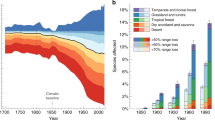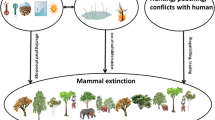Abstract
The Intergovernmental Panel on Climate Change (IPCC) predicts an increase in global temperatures of between 1.4°C and 5.8°C during the 21st century, as a result of elevated CO2 levels. Using bioclimatic envelope models, we evaluate the potential impact of climate change on the distributions and species richness of 120 native terrestrial non-volant European mammals under two of IPCC’s future climatic scenarios. Assuming unlimited and no migration, respectively, our model predicts that 1% or 5–9% of European mammals risk extinction, while 32–46% or 70–78% may be severely threatened (lose > 30% of their current distribution) under the two scenarios. Under the no migration assumption endemic species were predicted to be strongly negatively affected by future climatic changes, while widely distributed species would be more mildly affected. Finally, potential mammalian species richness is predicted to become dramatically reduced in the Mediterranean region but increase towards the northeast and for higher elevations. Bioclimatic envelope models do not account for non-climatic factors such as land-use, biotic interactions, human interference, dispersal or history, and our results should therefore be seen as first approximations of the potential magnitude of future climatic changes.



Similar content being viewed by others
Abbreviations
- IPCC:
-
Intergovernmental panel on climate change
- CCSR:
-
Change in climatically suitable range
- GDD:
-
Growing degree days
- PET:
-
Potential evapotranspiration
- ROC:
-
Receiver operating characteristic
- AUC:
-
Area under the curve
References
Andrewartha HG, Birch LC (1954) Weather: temperature. The distribution and abundance of animals. The University of Chicago Press, Chicago pp 129–206
Anon. (2001) Climate change 2001. The intergovernmental panel on climate change. Cambridge University Press, Cambridge
Araújo MB, Cabeza M, Thuiller W, Hannah L, Williams PH (2004) Would climate change drive species out of reserves? An assessment of existing reserve-selection methods. Glob Change Biol 10:1618–1626
Araújo MB, Pearson RG (2005) Equilibrium of species’ distributions with climate. Ecography 28:693–695
Araújo MB, Rahbek C (2006) How does climate change affect biodiversity? Science 313:1396–1397
Austin GE, Rehfisch MM (2005) Shifting nonbreeding distributions of migratory fauna in relation to climatic change. Glob Change Biol 11:31–38
Barnosky AD, Hadly EA, Bell CJ (2003) Mammalian response to global warming on varied temporal scales. J Mammal 84:354–368
Beerling DJ, Huntley B, Bailey JP (1995) Climate and the distribution of Fallopia-Japonica–use of an introduced species to test the predictive capacity of response surfaces. J Veg Sci 6:269–282
Berry PM, Dawson TP, Harrison PA, Pearson RG (2002) Modelling potential impacts of climate change on the bioclimatic envelope of species in Britain and Ireland. Glob Ecol Biogeogr 11:453–462
Brooks TM, Pimm SL, Oyugi JO (1999) Time lag between deforestation and bird extinction in tropical forest fragments. Conserv Biol 13:1140–1150
Case TJ, Holt RD, McPeek MA, Keitt TH (2005) The community context of species’ borders: ecological and evolutionary perspectives. Oikos 108:28–46
Crick HQP, Dudley C, Glue DE, Thomson DL (1997) UK birds are laying eggs earlier. Nature 388:526
Davis AJ, Jenkinson LS, Lawton JH, Shorrocks B, Wood S (1998) Making mistakes when predicting shifts in species range in response to global warming. Nature 391:783–786
Elith J, Graham CH, Anderson RP et al (2006) Novel methods improve prediction of species’ distributions from occurrence data. Ecography 29:129–151
Erasmus BFN, van Jaarsveld AS, Chown SL, Kshatriya M, Wessels KJ (2002) Vulnerability of South African animal taxa to climate change. Glob Change Biol 8:679–693
Fielding AH, Bell JF (1997) A review of methods for the assessment of prediction errors in conservation presence/absence models. Environ Conserv 24:38–49
Gordon C, Cooper C, Senior CA et al (2000) The simulation of SST, sea ice extents and ocean heat transports in a version of the Hadley Centre coupled model without flux adjustments. Climate Dyn 16:147–168
Graham RW, Lundelius EL, Graham MA et al (1996) Spatial response of mammals to late quaternary environmental fluctuations. Science 272:1601–1606
Guisan A, Thuiller W (2005) Predicting species distribution: offering more than simple habitat models. Ecol Lett 8:993–1009
Guisan A, Zimmermann NE (2000) Predictive habitat distribution models in ecology. Ecol Model 135:147–186
Hampe A (2004) Bioclimate envelope models: what they detect and what they hide. Glob Ecol Biogeogr 13:469–471
Hannah L, Midgley GF, Millar D (2002) Climate change-integrated conservation strategies. Glob Ecol Biogeogr 11:485–495
Hickling R, Roy DB, Hill JK, Thomas CD (2005) A northward shift of range margins in British Odonata. Glob Change Biol 11:502–506
Hickling R, Roy DB, Hill JK, Fox R, Thomas CD (2006) The distributions of a wide range of taxonomic groups are expanding polewards. Glob Change Biol 12:450–455
Hughes L (2000) Biological consequences of global warming: is the signal already apparent? Trends Ecol Evol 15:56–61
Ibáñez I, Clark JS, Dietze MC et al (2006) Predicting biodiversity change: outside the climate envelope, beyond the species-area curve. Ecology 87:1896–1906
Kerr J, Packer L (1998) The impact of climate change on mammal diversity in Canada. Environ Monitor Assess 49:263–270
Lugo AE, Brown SL, Dodson R, Smith TS, Shugart HH (1999) The Holdridge life zones of the conterminous United States in relation to ecosystem mapping. J Biogeogr 26:1025–1038
Luoto M, Poyry J, Heikkinen RK, Saarinen K (2005) Uncertainty of bioclimate envelope models based on the geographical distribution of species. Glob Ecol Biogeogr 14:575–584
McCarty JP (2001) Ecological consequences of recent climate change. Conserv Biol 15:320–331
Metz CE (1978) Basic Principles of Roc Analysis. Semin Nucl Med 8:283–298
Meynecke JO (2004) Effects of global climate change on geographic distributions of vertebrates in North Queensland. Ecol Model 174:347–357
Midgley GF, Hannah L, Millar D, Rutherford MC, Powrie LW (2002) Assessing the vulnerability of species richness to anthropogenic climate change in a biodiversity hotspot. Glob Ecol Biogeogr 11:445–451
Mitchell-Jones AJ, Amori G, Bogdanowicz W et al (1999) The atlas of European mammals. T & A D Poyser, Academic Press, London
Parmesan C, Yohe G (2003) A globally coherent fingerprint of climate change impacts across natural systems. Nature 421:37–42
Pearson RG, Dawson TP (2003) Predicting the impacts of climate change on the distribution of species: are bioclimate envelope models useful? Glob Ecol Biogeogr 12:361–371
Pearson RG, Dawson TP, Berry PM, Harrison PA (2002) SPECIES: a spatial evaluation of climate impact on the envelope of species. Ecol Model 154:289–300
Peterson AT, Ortega-Huerta MA, Bartley J et al (2002) Future projections for Mexican faunas under global climate change scenarios. Nature 416:626–629
Pope VD, Gallani ML, Rowntree PR, Stratton RA (2000) The impact of new physical parametrizations in the Hadley Centre climate model: HadAM3. Climate Dyn 16:123–146
Prentice IC, Cramer W, Harrison SP et al (1992) A global biome model based on plant physiology and dominance, soil properties and climate. J Biogeogr 19:117–134
Root TL, Price JT, Hall KR et al (2003) Fingerprints of global warming on wild animals and plants. Nature 421:57–60
Schwartz MW, Iverson LR, Prasad AM, Matthews SN, O’Connor RJ (2006) Predicting extinctions as a result of climate change. Ecology 87:1611–1615
Segurado P, Araújo MB (2004) An evaluation of methods for modelling species distributions. J Biogeogr 31:1555–1568
Skov F, Svenning JC (2004) Potential impact of climatic change on the distribution of forest herbs in Europe. Ecography 27:366–380
Smith FA, Betancourt JL (1998) Response of bushy-tailed woodrats (Neotoma cinerea) to late quaternary climatic change in the colorado plateau. Quat Res 50:1–11
Smith FA, Browning H, Shepherd UL (1998) The influence of climate change on the body mass of woodrats Neotoma in an arid region of New Mexico, USA. Ecography 21:140–148
Svenning JC, Skov F (2004) Limited filling of the potential range in European tree species. Ecol Lett 7:565–573
Swets JA (1988) Measuring the accuracy of diagnostic systems. Science 240:1285–1293
Thomas CD, Cameron A, Green RE et al (2004) Extinction risk from climate change. Nature 427:145–148
Thomas CD, Lennon JJ (1999) Birds extend their ranges northwards. Nature 399:213
Thuiller W (2004) Patterns and uncertainties of species’ range shifts under climate change. Glob Change Biol 10:2020–2027
Thuiller W, Lavorel S, Araújo MB, Sykes MT, Prentice IC (2005a) Climate change threats to plant diversity in Europe. Proc Nat Acad Sci U S A 102:8245–8250
Thuiller W, Lavorel S, Araújo MB (2005b) Niche properties and geographical extent as predictors of species sensitivity to climate change. Glob Ecol Biogeogr 14:347–357
Tøttrup AP, Thorup K, Rahbek C (2006) Patterns of change in timing of spring migration in North European songbird populations. J Avian Biol 37:84–92
Vaughan TA, Ryan MR, Czaplewski NJ (2000) Mammalogy. Thomson Learning
Walther GR, Berger S, Sykes MT (2005) An ecological ‘footprint’ of climate change. Proc Roy Soc B-Biol Sci 272:1427–1432
Walther GR, Post E, Convey P et al (2002) Ecological responses to recent climate change. Nature 416:389–395
Wilson RJ, Gutierrez D, Gutierrez J et al (2005) Changes to the elevational limits and extent of species ranges associated with climate change. Ecol Lett 8:1138–1146
Acknowledgements
We would like to thank A. J. Mitchell-Jones for providing us with the digital mammal distribution data, and the Danish Natural Science Research Council for economic support (grant #21-04-0346 to JCS and grant #21-03-0221 supporting IL and CR). Additional thanks to Tom S. Romdal for comments on earlier versions of the manuscript.
Author information
Authors and Affiliations
Corresponding author
Rights and permissions
About this article
Cite this article
Levinsky, I., Skov, F., Svenning, JC. et al. Potential impacts of climate change on the distributions and diversity patterns of European mammals. Biodivers Conserv 16, 3803–3816 (2007). https://doi.org/10.1007/s10531-007-9181-7
Received:
Accepted:
Published:
Issue Date:
DOI: https://doi.org/10.1007/s10531-007-9181-7




